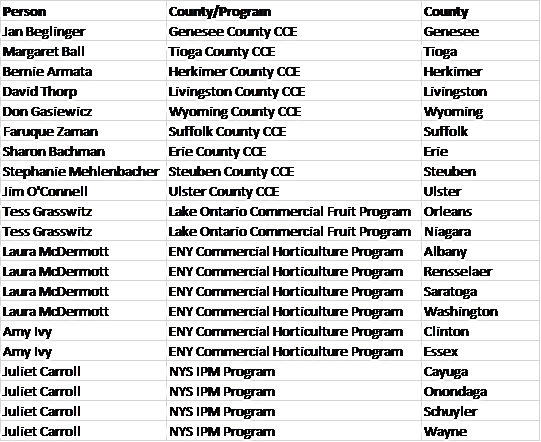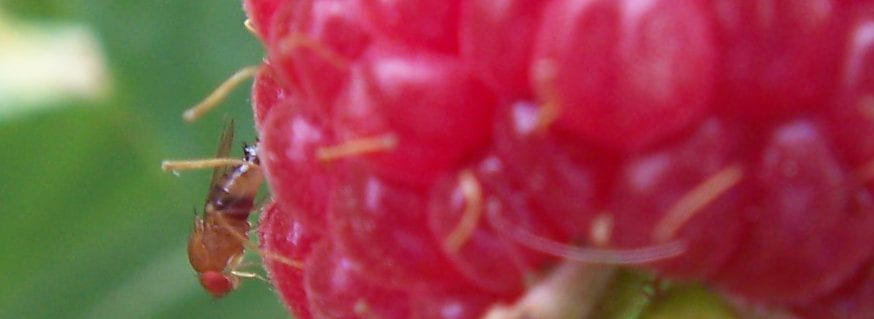Spotted wing drosophila (SWD) is native to South East Asia. It was first recorded as an invasive species in Hawaii in 1980, and in both California and parts of Europe in 2008. Since then it has spread rapidly throughout temperate North America and Europe, mainly due to global trade combined with an initial lack of regulatory controls. Its annual rate of range expansion has recently been estimated at approx. 1000 km (~620 miles) per year, and it is now established in parts of South America and the Middle East.
As a result of its global economic impact, spotted wing drosophila is the target of an intense global research effort encompassing various aspects of its biology and control. This article summarizes the results of some of this recent research that offers potential for the development of future pest management strategies. Please note that these reports do not constitute recommendations at this stage.
Summary of life-cycle
Spotted wing drosophila overwinters as a specialized (darker) adult morph that has greater cold tolerance than the summer form. Overwintered flies emerge in spring and feed on nectar from early flowering weeds and crops. Overwintering adults may live for more than 200 days, but the longevity of the summer form is considerably less. Reproductively mature female flies lay eggs in the ripening fruits of a wide range of host plants, including many wild, uncultivated species. Each female may produce 100–400 eggs, laying approximately 20 per day (depending on host availability and environmental conditions).
Recent research from Italy has shown that spotted wing drosophila can complete its lifecycle at temperatures as low as 53 °F; however, adult activity is highest at temperatures between 68 and 77 °F, and is reduced at temperatures above 86 °F. Adults are most active at dawn and dusk.
Larvae develop inside the fruit and complete their development in 3-13 days (depending on temperature). Pupation can occur in the fruit or in the soil, and the entire life-cycle can be completed in approx. 7–10 days (again, depending on temperature). Under optimal conditions, up to 13 generations per year are possible, although in the US and Canada 3–9 generations are more typical. Canadian research suggests that the lower lethal temperature for adult flies is in the region of 19 °F, although cold tolerance depends on the extent of prior exposure to fluctuating cool temperatures. There is evidence to suggest that females are more cold-tolerant than males.
Recent research results
i. Host plants
Fruits of susceptible host plants are liable to attack as soon as the fruit begins to soften and show color. Research with both raspberries and blueberries has shown that green, hard fruits are not at risk. The likelihood of egg-laying increases as the force needed to penetrate the fruit decreases: hence egg-laying is consistently high in raspberry and other thin-skinned fruits. In a recent US study, calcium treatments applied to blueberries in a field experiment produced firmer fruits that harbored fewer SWD eggs than fruits from untreated plots.
The wide host plant range of spotted wing drosophila can influence population levels at the landscape scale. In one US study, the abundance of wild hosts in nearby woods and hedgerows was implicated in the increased early-season risk of spotted wing drosophila in adjacent raspberries. However, it did not appear to influence the subsequent rate of population development in those crops.
As an indication of the wide host plant range of spotted wing drosophila, in recent field surveys in Europe, more than 24,000 adult flies successfully emerged from the fruits of 84 plant species from 19 different plant families, 38 of which were non-native species. The highest infestations were found in species of Cornus (dogwoods), Prunus (relatives of stone fruits such as cherries, plums, etc.), Rubus (raspberries, blackberries, and relatives), Sambucus (elderberry) and Vaccinium (blueberries and relatives). US research has shown a similarly wide range of hosts, including many of the above, as well as Morus (mulberry), edible blue honeysuckle (also known as haskap or honeyberry), and some common herbaceous weeds such as Solanum dulcamara (bittersweet nightshade). In Europe, spotted wing drosophila has also been found infesting mistletoe berries (Viscum album) – probably one of the earliest host fruits available for spring egg-laying.
In another European study, the fruits of several plants stimulated egg-laying by SWD females, but did not support full larval development and successful adult emergence. If these lab reports are supported by future field studies, such plants might be a useful component of an integrated control strategy as trap plants or so-called 'dead-end' hosts. For such an approach to be successful, however, the fruits must either be significantly more attractive than the crop being protected, or be present either earlier or later than the fruits of the target crop.
ii. Interactions with yeast
Once mated, adult female spotted wing drosophila respond strongly to odors produced by wild yeast species associated with fruit. These yeast odors are used as feeding cues, and may form the basis for developing an “attract-and-kill” strategy: in recent research, exposing flies to a mixture of yeast and insecticide reduced egg-laying and increased the mortality of adult flies compared to insecticide treatments alone. However, related work has shown that the effect is dependent on both the insecticide used, and the species of yeast. In some cases, there was no additional benefit from adding yeast to an insecticide spray that was also supplemented with cane sugar.
A rather more advanced approach to exploiting the attraction of SWD to yeasts involves the use of a genetically modified yeast strain to disrupt the expression and regulation of some of the pest’s critical genes by interfering with the normal functioning of its ribonucleic acid (RNA). Such ‘RNA interference’ techniques (RNAi) are being developed for many important crop pests. Recent lab-based research in California involved feeding a genetically modified yeast strain to adult spotted wing drosophila and recording mortality, activity and post-treatment egg-production: while there was no increase in fly mortality as a result of the treatment, the flies were less active and laid fewer eggs, prompting speculation that further refinements of the technique might have a future role in pest management.
iii. Environmental factors
Previous research has shown that SWD trap catches decline when humidity is low. Several research groups are now investigating whether different pruning and irrigation practices can reduce within-crop temperature and humidity and hence slow the rate of SWD population increase. Other research groups are comparing the survival of SWD in blueberry plantings with or without black plastic weed mats: the higher temperatures associated with the mats may reduce the survival of pupae in infested fruit that falls to the ground.
iv. Biological control
Various research groups in both North America and Europe have addressed the possible impact on spotted wing drosophila of both native natural enemies and a range of commercially available predators, parasitic nematodes and fungal pathogens. However, many of the studies have been conducted only under laboratory conditions and the results have been rather variable.
Two species of parasitic wasps (parasitoids) (Trichopria drosophilae and Pachycrepoideus vindemiae) have been found attacking SWD pupae in both the USA and Europe, as well as in the pest's native range (various parts of Asia, including Japan and Korea). Trichopria drosophilae has a narrower host range than P. vindemiae and may have potential for mass-rearing for use in augmentative release programs. Additional parasitoids collected from South Korea are currently undergoing evaluation under quarantine in California, but it will be some time before such tests are completed.
v. Chemical control
At present, commercial producers rely heavily on season-long applications of a rather limited range of insecticides for spotted wing drosophila. With a pest such as this, with rapid rates of development and multiple generations per year, the risk of selecting for insecticide resistance is high. This is particularly true for enclosed tunnel systems (because of limited fly movement) and in organic plantings, where there are few effective chemical control options. There is already some evidence of reduced susceptibility to spinosad (Entrust®) in some organically managed berries in the western US. On the other hand, a recent study in Canada showed no increase in resistance to malathion in a laboratory population of SWD exposed to sub-lethal concentrations for 30 generations. Baseline monitoring for resistance to the most widely used insecticides is currently being conducted in fruit-producing regions in various parts of the US. Such monitoring will provide a valuable early-warning system if and when resistance develops.
In the meantime, a recent report from Georgia on the efficacy of insecticides used for SWD in blueberries showed that the adjuvant Nu Film P had some effect on prolonging the activity of spinetoram and spinosad after a simulated rainfall equivalent to 0.5", and of malathion after a rainfall of approx. 1". Nu Film P is listed by the Organic Materials Review Institute (OMRI) as suitable for use in organic production.
Future prospects
In conclusion, the heavy investment in research on spotted wing drosophila is now starting to produce results that at the very least will provide some additional management tools, and which in future may form the basis of a multi-tactic, integrated approach to the management of this pest.
This article was contributed by Tess Grasswitz, Extension Associate, Lake Ontario Fruit Program, Cornell Cooperative Extension. Originally published in Fruit Notes, Vol 16, Issue 18, August 18, 2016.




 The national Sustainable Spotted Wing Drosophila Management for United States Fruit Crops project funded by the USDA Specialty Crops Research Initiative needs and will benefit from feedback from growers across the country.
The national Sustainable Spotted Wing Drosophila Management for United States Fruit Crops project funded by the USDA Specialty Crops Research Initiative needs and will benefit from feedback from growers across the country. Funding for this project, Sustainable Spotted Wing Drosophila Management for US Fruit Crops, was provided by the National Institute of Food and Agriculture, U.S. Department of Agriculture Specialty Crops Research Initiative under Agreement No. 2015-51181-24252.
Funding for this project, Sustainable Spotted Wing Drosophila Management for US Fruit Crops, was provided by the National Institute of Food and Agriculture, U.S. Department of Agriculture Specialty Crops Research Initiative under Agreement No. 2015-51181-24252.